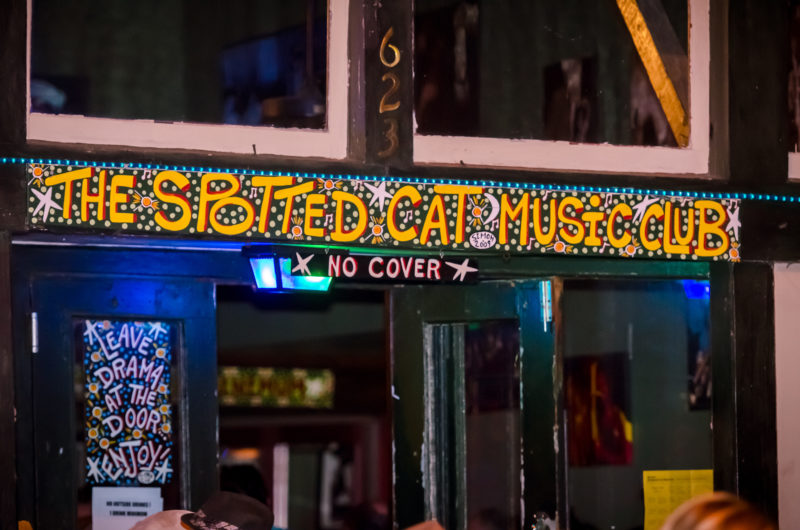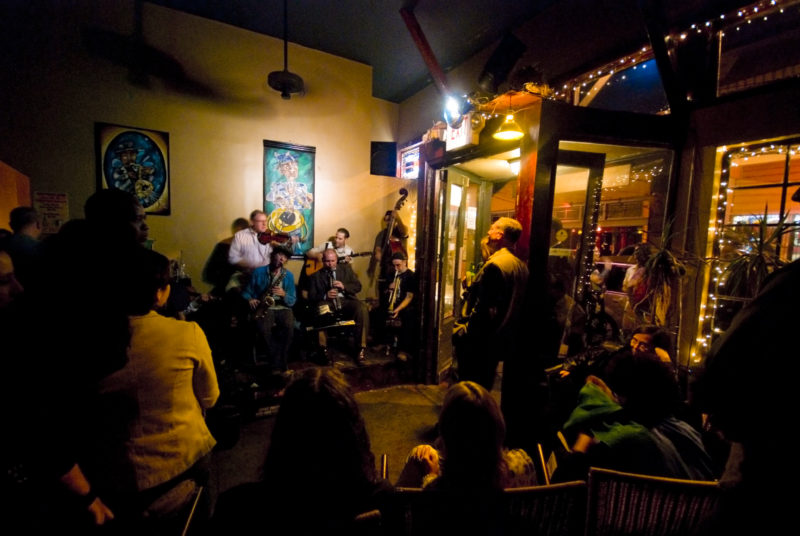Located near the French Quarter, the Spotted Cat Music Club is situated on Frenchmen Street, a neighborhood prized for its funky bars and constant stream of live music. Opened in December, 2000 as a club for local musicians and features jazz, but also “Klezmer, Biguine, Balkan, and more” (Roberts, Robin. “Two Sides of Frenchmen Street and New Orleans Hybrid Music: The Panorama Jazz Band and the Zydepunks.” Popular Music & Society 31, no. 2 (May 2008): 201-212). In its early days, the club struggled to bring in customers, but after surviving Hurricane Katrina and numerous changes in ownership, the club is now a staple of Frenchmen Street.
Origins

The colorful sign flaunts it’s cover-free entry. Photo by Billy Metcalf Photography, reproduced here under the Creative Commons.
In May of 2000, Patricia A. Cone, Edward W. Parrish, and Albert E. Gauthier Jr. purchased a building that originally began as a restaurant by the name of Frenchmen Oyster House (Times-Picayune, The (New Orleans, LA). “Real Estate.” The Times-Picayune: March 24, 1974). At first, opening a new bar on a street already filled with bars made it challenging for the new owners to attract customers to the Spotted Cat, and the locale was often empty (Times Picayune, The (New Orleans, LA). May 7, 2000). However, over time the owners managed to establish a good reputation for their new business by bringing in a constant stream of good music (Aiges, Scott. “JUST THE RIGHT MIX – Hanging out at d.b.a. might just give you a taste for the finer things.” The Times Picayune. March 23, 2001).
Hurricane Katrina
No one can deny the devastating effects that Hurricane Katrina had on the city of New Orleans, the damages extending way beyond the year of 2005 when it actually occurred. Frenchmen Street was not excluded from this. Many of the bars were forced to close, and the owners who managed to pull their businesses through were regarded as a form of heroes. The opening of any new bar was a rare occasion worth celebrating. The Spotted Cat, a familiar place in a time of devastating change, grew more popular than ever. Although the shingles on the building were loose and tattered pieces of siding threatened to fall off at any moment, the music had a strong enough sound to transport people back to what was viewed as a better, safer past. The owners had no trouble filling the relatively small venue every night (Marszalek, Keith I. “Frenchmen is cooking at Ray’s and beware of snakes this Monday.” The Times-Picayune: July 31, 2006 (1). Web. 30 October, 2011).
New Ownership
In the summer of 2009, the original owners of the Spotted Cat sold the club to a new proprietor, Bill “Negril” Szarabajka. Szarabajka already owned another music club, Café Negirl, on Frenchmen Street and was familiar with the industry. Despite his experience in the business, the new owner’s temporary change of the name to Jimbeaux’s was a not a very popular variation with the locals. The music bar failed to establish regular hours, and its state of being in limbo left many locals missing the former Spotted Cat. The new changes to the once thriving club proved so unpopular that Jimbeaux’s closed down from September to October 2009 (Kemp, John. âSome familiar names missing on Frenchmen Street.â The Times-Picayune: August 27, 2009. Web. 30 October, 2011).
When the club reopened, the locale was renamed its original name, the Spotted Cat, but two words were added to the title: Music Club. Renovations were done on the barroom, increasing the space for customers by thirty percent and eliminating a narrow walkway (Grunfeld, David. “The Spotted Cat.” The Times-Picayune: July 20, 2010 (1). Web. 30 October, 2011). Contrary to the changes made to the club’s exterior, Szarabajka went back to the bar’s old schedule and traditions when it came to deciding which artists would be featured at his club. As before, the New Orleans Cottonmouth Kings, made up of six out of seven members of the former New Orleans Jazz Vipers Band, were featured every Friday at 10 P.M. Another traditional bohemian jazz bands that returned to the Spotted Cat was Washboard Chaz Leary. Locals were extremely pleased with the Spotted Cat’s reopening, as the demand for unamplified, traditional jazz grew in the city (Spera, Keith. “Spotted Cat to reopen on Frenchmen Street.” The Times-Picayune: October 6, 2009 (1). Web. 30 October 2011).
Fire
Around 8 A.M. on January 9, 2010, neighbors to the Spotted Cat called the fire department after smelling smoke. The fire mainly damaged the buildings on 619 and 621 Frenchmen Street, but Spotted Cat was certainly vulnerable. Thirty six fire fighters fought off the blaze while struggling to protect the beloved Spotted Cat. Unfortunately, the neighbor’s houses went up in flames, one of them being a mask maker who lost many of his most precious pieces of art. The cause of the fire was said to be utilities left running in the building. Nonetheless, the neighboring mask maker, the person whose home was the origin of the fire, claimed that nobody had been home the day before. Shortly afterward, the owners of the Spotted Cat hired electricians to check the building’s wiring to prevent any future disasters (Vargas, Ramon Antonio. “Marigny fire wrecks mask maker’s home, Frenchmen Street club threatened.” The Times-Picayune: January 9, 2010 (1,2). Web. 30 October, 2011).
Reaching Out
With memories of Hurricane Katrina still fresh in the minds of local New Orleanians, many people and musicians felt the urge to reach out a helping hand for Haiti in the time of its catastrophic earthquake. On Sunday, January 24, 2010, Café Negril and the Spotted Cat hosted a day-long event with two dozen bands for the benefit of the Haitian people. People were encouraged to donate $10 in order to be able to enjoy music from noon to midnight that day. All of the proceeds went to Doctors Without Borders, an international medical relief organization that greatly helped out the Haitian people. Out of thirty bands that the new owner, Szarabajka, asked all of them jumped at the opportunity to play for such a worthy cause. Some of the bands featured at the Spotted Cat were Pat Casey, the Tin Men, Washboard Chaz, the Panorama Jazz Band, and Loose Marbles (Spera).
Cultural Significance

The Spotted Cat retains a loyal fan base. Photo by Flickr user Strollerdos, reproduced here under the Creative Commons.
Currently, locals look gratefully at the Spotted Cat Music Club as one of those places that never change. One example of is the lack of cover, something that has always been in place and probably always will be. A crowd of people always hangs around outside the bar, and the inside is usually packed. The tourists and jazz enthusiasts take up the tables while everyone else leans against a wall. Everyone can be heard talking loudly over their drinks, creating a convivial atmosphere. Swing dancing is very popular, and it certainly adds to the vibe of the bar being a fun place for any music lovers. Both the performers and the audience are somewhat of a glamorous spectacle without needing to be pretentious about it. Simply put, the Spotted Cat is a good bar to start out a Friday night or enjoy a drink with a diverse group of people, among which one may find a relaxed gathering of locals (Reid, Molly. “One-Night Stands: Discover essential New Orleans on Frenchmen Street.” The Times-Picayune: July 1, 2011 (1). Web. 30 October, 2011).






